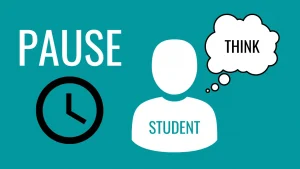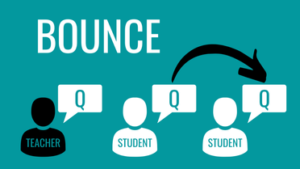Questioning pose, pause, pounce, and bounce is a technique to assist instructors in progressing from excellent to outstanding. It also aids in classroom differentiation and encourages instructors to take risks.
When called upon, students do not raise their hands. Instead, once the question is stated and halted (i.e., wait period or think period), you randomly choose students so that each student can generate a response.
Table Of Contents
Introduction to Questioning Pose, Pause, Pounce and Bounce
- The concept of questioning pose, pause, pounce and bounce encouraged instructors to take chances and elicit ‘learning’ in the classroom.
- According to researchers, teachers ask between 300 and 400 questions daily, which may amount to 70,000 per year and roughly 3 million by the time they retire.
- As a result, we always ask questions in class, from information retrieval to interpreting instructions and verifying learning.
- However, lousy teachers simply ask from someone, which are usually closed questions with specified short solutions.
- Although this is beneficial for assessing topic knowledge and maybe broad comprehension in disciplines such as mathematics, it does not encourage critical thinking or students’ analysis and assessment abilities.
Why Questioning Pose, Pause, Pounce and Bounce Is Useful?
| This method is useful to raise awareness of the new Ofsted standards. | This tactic encourages instructors to take chances and elicit “learning” in the classroom. |
| By altering our questioning strategies, it also serves as a good focal point for distinguishing goals and educational experiences. | No more closed questions! |
Techniques of Questioning Pose, Pause, Pounce and Bounce
Poor questioning techniques will allow students to answer closed questions by raising their hands. Many educationalists now consider this a simple no since it implies that students who do not wish to engage would sit there quietly.
It means that you can’t ask questions based on students’ abilities or determine if a wide variety of students understand what’s being taught. The pose, pause, pounce, and bounce (PPPB) approach promoted by Ross Morrison McGill and ascribed to Pam Fearnley is one way around this.
The objective is to engage all students by providing a question to which any of them may have to respond. It would be a hands-on exercise that would allow kids time to reflect. McGill explains the process as follows:
POSE
The teacher begins by asking pupils to answer a question. The inquiry should be open-ended so that students may present various perspectives. Closed and lower-order questions are less successful for this asking style since students can only react with short responses and do not produce the needed broadness and depth of discussion and debate.
When open-ended questions are used, there is frequently no ‘correct’ response; instead, each student’s distinct opinions are legitimate and can add to the conversation. Here is an example of an open-ended question:
Is capitalism a positive force?
PAUSE
After the instructor has asked an acceptable question, it is critical to give pause and enough time to respond. Allowing adequate thinking time is sometimes disregarded by instructors, even though it is a vital element of the questioning techniques.
It refers to ‘wait time,’ or the period between posing a question and anticipating an answer. Mary Budd Rowe invented the phrase “wait time” in 1972. She did an observational study and discovered that instructors’ average wait time was barely 1.5 seconds.
She even discovered a case where the wait time was as small as 0.1 seconds. The research was done many years ago in the 1970s, but additional studies have been undertaken in recent decades with consistent results.
As a result, professors usually do not give pupils enough time to reflect and react when they pose a question to someone. A minimum time is given to students when they need to recollect knowledge and facts they previously knew (closed-ended questions).
When students need to produce new thinking and learning, it is critical to provide adequate wait time. There is no fixed time that teachers should give before prompting a student for a response. However, current research suggests that 10-20 seconds is a more acceptable wait period to allow for more meaningful thought.
Don’t be afraid of stillness. Teachers keep their lessons moving and maintain active engagement, so quiet may be unsettling. However, it is critical to take a moment to slow down the lecture and give pupils time to reflect and respond meaningfully.
POUNCE
The instructor has asked a suitable question, given pupils enough time to reflect and respond, and now it’s appropriate for the teacher to pounce on a student for an initial response. Pounce on a pupil may be scary for both the kid and the teacher.
On the other hand, the term’ pounce’ is presumably only included in this strategy because it rhymes with ‘bounce.’ Instead of randomly picking a student, the teacher will pick a suitable student to offer a first response to the query.
Since there is no right or incorrect answer to the teacher’s open-ended query, most pupils will feel secure and at ease offering a response. Whatever the student is able and willing to contribute will serve as the discussion’s jumping-off point, whether it be a whole answer, a partial answer, a few essential words, or a single fact.
BOUNCE
The teacher will pass the student’s first response to the question to another student when the student has finished. The teacher will ask the second student a question about the first student’s response.
Are they in accord or not? Do they have any more comments? Do they wish to offer a different response? The ABC Questioning approach is another straightforward and efficient questioning method that we urge all instructors to utilize in classes.
It is also connected with the notion of students supporting, expanding upon, and challenging one another’s ideas and replies. However, this line of questions does not end here. You can repeat any part of the procedure to keep the conversation continuing.
You might continue to pounce and bounce questioning technique around the group, for instance, to spark a much wider conversation and get a variety of viewpoints.
Conclusion
The questioning pose, pause, pounce and bounce technique allows students and teachers to participate effectively in class. Diversifying the questioning methods also helped the institution focus on distinguishing learning objectives and experiences. No further close-ended questions.
Also Read: Tips for Teaching Reading Skills & Tips for Getting Teaching Jobs Abroad



